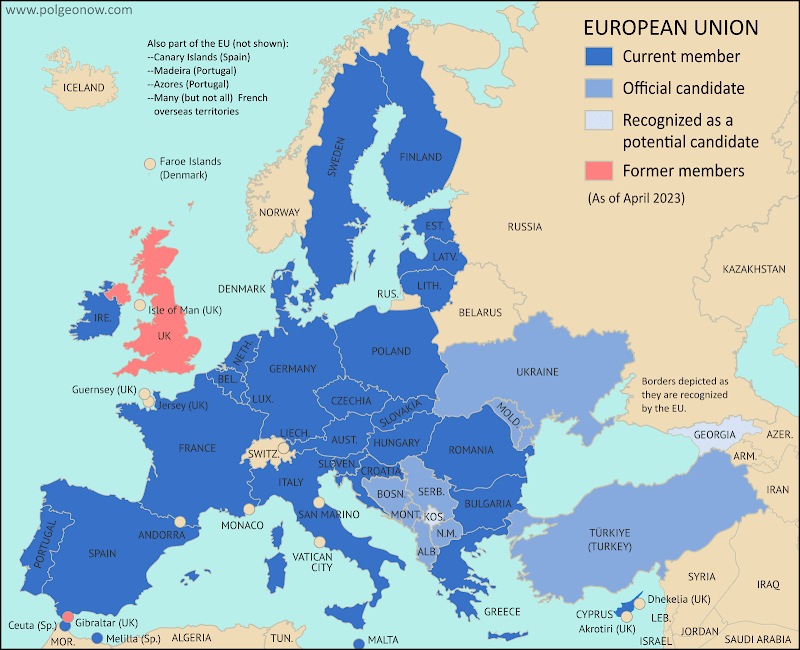 |
| Map by Evan Centanni, from blank map by Ssolbergj. License: CC BY-SA |
Croatia Joins Eurozone, Leaves ERM II
On January 1, 2023, Croatia retired the Croatian kuna currency as the country's official money, replacing it with the shared European currency known as the "euro". By doing this, the country became the 20th official member of the "euro area", better known as the Eurozone - not to be confused with the European Union (EU), a closely-related organization that the Eurozone basically part of. On the same day, Croatia also joined Europe's free-travel Schengen Area, another EU-connected grouping of countries.
Croatia had been participating in the "European Exchange Rate Mechanism II" (ERM II or ERM-2), a "waiting room" system for countries in the process of adopting the euro, since mid-2020. Through the ERM II program, the EU's European Central Bank helps stabilize the exchange rates between the euro and participant countries' currencies, and those countries adjust their banking systems be fully compatible with the Eurozone's own system. Croatia completed the pre-euro transition process within the expected 2-3 year waiting period, but Bulgaria, which joined ERM II at the same time as Croatia, has delayed its switch to the euro until 2025.Croatia's previous currency, the kuna, continued to be used while the country was in ERM II, but was "semi-pegged" to the euro - only allowed to vary 15% above or below a set exchange rate. Now that the country has officially switched, only euros are accepted for payment, but people can still trade their old kuna coins for euros until the end of 2025, and can trade in kuna bills indefinitely.
 |
| The full European Union (EU) and prospective members |
For more on which countries do and don't use the euro, check out our Eurozone explainer article, which has been updated to June 2023.
Other Changes to the Map (Why did it turn purple?)
For people interested in the details of PolGeoNow's Eurozone map, there are a few other revisions we've made since the previous edition of July 2020:- Most obviously, we've changed the colors on the map, with the main Eurozone and EU colors switched from shades of blue to shades of purple. This is because several people told us they have trouble telling apart blue-shaded countries from blue bodies of water on our maps. Though most readers don't seem to have this issue, we're dedicated to making our maps accessible to as wide an audience as possible, and it was a simple change. We plan to make the same change to our European Union and Schengen Area maps the next time we update them.
- We also changed the colors of the non-EU euro countries from green and yellow to reddish and orangish respectively. This is to make the map more readable for people with common types of colorblindness, for whom either the green or the yellow likely looked very similar to the tan color of the non-EU, non-euro countries. This is a policy we follow as often as possible when making our maps.
- Turkey, a non-EU, non-euro country at the southeastern corner of Europe, recently changed its official English name to "Türkiye". To accurately show the official situation on maps of the world's legally-recognized countries and borders (which are invented by people and governments anyway), PolGeoNow sticks to using the official short names of countries unless they're nonexistent or almost never used.
- We've added labels for Ceuta and Melilla, two areas on the coast of North Africa that are in the Eurozone because they're governed as part of Spain. This was already the case before - we just wanted to make it clearer for readers who might be wondering why there are two tiny bits of Eurozone in Africa.
Learn More: Which countries use the euro, and which European countries don't?
